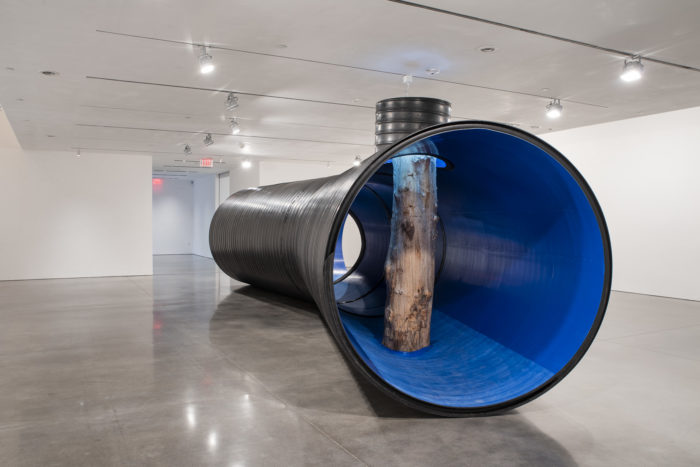
- Source: CULTURED MAGAZINE
- Author: Osman Can Yerebakan
- Date: JUNE 28, 2018
- Format: ONLINE
For Artist Oscar Tuazon
the Journey Is Another Medium
For Oscar Tuazon, mobility is the subject, rather than the function. He’s currently traveling between his studio and Minnesota, where he installed one of his Water School sculptures at Winona’s Hemp and Heritage Farm, a Native American-run hemp farm advocating sustainable production of clothing and consumables. Earlier in May, the same sculpture had “parked” in front of The Brant Foundation Art Study Center as part of the artist’s group exhibition with painters Joe Bradley and Michael Williams. “Motion makes the work so much stronger,” the artist explains over the phone from his West Coast studio. “The ideal for a post-studio practice has always been to work in motion, not only for Land Art, but for any genre, in order to create connections between vast distances.”
Entitled Mother Model (2018), the mobile sculpture consists of a pick-up truck hauling a pipe in its cargo bed. Covered with urethane and foam, this pipe, not unlike an industrial Minimalist sculpture à la Richard Serra, is accentuated by a gentle birch tree piercing through its middle. The artist had driven the work to Connecticut from Cedar Spring, Nevada, which has been in the news due to ongoing debates between the authorities and locals about potential consequences of building a water pipeline. “This is the power of abstraction,” underlines 42-year-old Tuazon, referring to the non-representational nature of his pipe sculptures. “You can take it from one context and transfer the meaning into another without losing the reality of the object and encounter.” The Brant Foundation exhibition also includes Une colonne d’eau (Life prototype) (2017), another HDPE pipe sculpture inviting the public walk through its colossal tunnel-like body. The work was sitting at Place Vendôm in Paris last fall as an industrial accent to the square’s 19th century architecture.

Une colonne d’eau (Life prototype), 2017. Photo by Laura Wilson.
When an invisible infrastructural tool comes out to daylight in the form of a sleek work of art and suggests public engagement, one realizes its dwarfing size and potential impacts on natural and social habitat. Tuazon aims to unravel ideas and facts for public conversation, and in this case, the topic is the environmental crisis and urgency for clean water. Transforming sculpture into a social catalyst, he not only triggers awareness for crucial issues, but also offers a hub for contemplation. Passing through an encapsulating pit, participants find tranquility in its smooth blue interior, while facing the reality of its socio-political resonance.
“I am interested in reversing the rules of engagement,” explains Tuazon in his soft-spoken way, mentioning his plan to install one of his “Water School” sculptures in solidarity with the Cedar Spring community. Either merging a stage and a fireplace into one entity for his Skulptur Projekte Münster project Burn the Formwork or placing a basketball hoop made out of a tree at the Brooklyn Bridge Park, Tuazon has long been invested in gathering communities together around sculpture and the power of everyday utilitarian objects. The concept of stripping tools from their function was evident in his recent solo exhibition at Chelsea’s Luhring Augustine, where he exhibited works from his Zome Alloy series with modular wooden compartments that allow for multiple display methods. Exhibited in various parts of the globe over the years, including Messeplatz during Art Basel 2016, the work reminds topics that might pass by the mainstream attention. “I am realizing that a project like Water School is a long-term engagement and commitment to think beyond protest actions for reliable alternatives for devastating effects of fossil fuel extraction,” Tuazon says when asked about the future of his practice.

